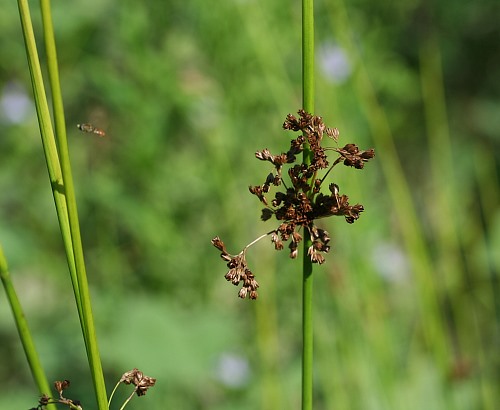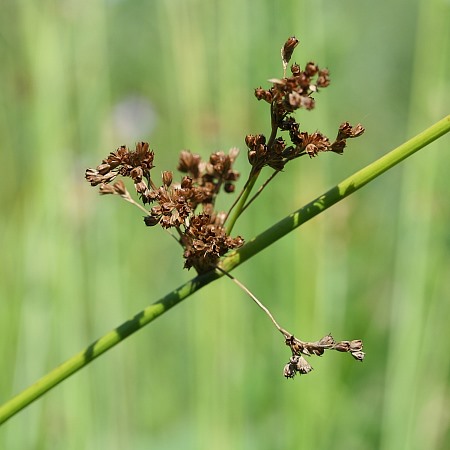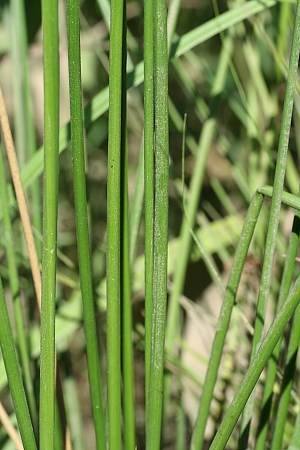Description: This perennial rush is about 2-4' tall, forming vegetative clumps of unbranched stems that are erect to ascending. Each stem is medium green, terete (round in cross-section), soft, and hairless; it is typically about 4 mm. across at the base, becoming gradually more slender to about 2 mm. across near the inflorescence. Because each stem lacks cauline leaves, it has a naked appearance. At the base of each stem, there is a prominent dark-colored basal sheath; it is usually about 2-3" long and lacks any blade. Older sheaths often exist underneath this basal sheath, but they are withered and inconspicuous.

The central stem terminates in an inflorescence and its stem-like bract. This bract is about 4-12" long and looks like a continuation of the stem beyond the inflorescence. The inflorescence is a compound umbel or panicle of florets that spans about ¾–4" across; it hangs from one side. Sometimes this umbel has rays (or branches) that are bunched together, while at other times the rays are widely spreading. The rays of this inflorescence are slender, slight curved or drooping, and variable in length. At the base of the umbel, there may be a few basal bracts that are small and scale-like. Each terminal ray of the umbel has a single floret that is 2-3.5 mm. in length. Depending on the stage of their maturity, the florets can be green, straw-colored, or dark brown. Each floret consists of a 3 sepals, 3 petals, a central ovary (or seed capsule), 3 stamens, and a single style. The petals are inconspicuous and look like inner sepals. The sepals and petals are lanceolate in shape, spreading slightly away from ovary/capsule. The latter is ovoid-obovoid in shape and becomes about the same length as the sepals and petals at maturity; the ovary/capsule often has a tiny inconspicuous beak at its apex. The blooming period occurs during the summer. Cross-pollination is achieved by the wind. At maturity, the seed capsule splits open into 3 parts to release the tiny seeds, which can blow about in the wind or float on water. The seeds are about 0.5 mm. long, flattened, ellipsoid-ovoid, and brown; the 2 endpoints of each seed have tiny beaks. The root system consists of short scaly rhizomes and coarse fibrous roots.

Cultivation:
The
preference is full sun, wet conditions, and mucky soil; some sand,
gravel, or silt is readily tolerated. This rush can be established in
new locations by dividing the clumps or digging up the rhizomes;
germination of the seeds is slower and more problematic. It is possible
to establish this rush at drier sites (e.g., in an ornamental garden),
but this will require occasional watering during dry spells.
Range & Habitat:
The native Soft Rush is common in southern Illinois, occasional in
northern
Illinois, and uncommon or absent in the central part of the state (see Distribution
Map). For some reason, it has an oddly bifurcated range
within the state. In addition to many areas of North America, this rush
also occurs in Eurasia. Across its extensive range, many different
varieties have been described. Apparently, only var. solutus
occurs in Illinois. Habitats include prairie swales, soggy meadows
along rivers, sloughs, marshes, seeps, edges of ponds and rivers,
ditches, and poorly drained areas of fallow fields. This moderately
robust rush can tolerate some degradation of a wetland site if it is
not too severe.
Faunal Associations:
Some insects feed on Juncus spp. (Rushes),
including Plateumaris pusilla (Leaf Beetle
sp.), Macrosteles potoria
(Leafhopper sp.), larvae of Eutomostethus luteiventris
(Sawfly sp.), and larvae of Archanara subflava
(Subflava Sedge Borer Moth). Of these, the larvae of the preceding
sawfly species are associated with the Soft Rush in particular. It is
possible that some wetland and songbirds feed on the seed capsules of
wetland rushes; if so, their importance as a food source is minor.
Among mammalian herbivores, Muskrats are known to feed on the foliage
and rootstocks of Soft Rush and other rushes occasionally. Because Soft
Rush is fairly tall and can form dense colonies, it has the capacity to
provide significant cover and nesting habitat for wetland birds and
other kinds of wildlife. Because the tiny seeds can cling to the
feathers or muddy feet of ducks and other wetland birds, these animals
help to distribute this rush to new wetland sites.
Photographic Location:
A drainage ditch in Urbana, Illinois, where this rush was probably an
escape from cultivation in a wetland garden. The photographed plants
have reached
the mature fruiting stage where they're releasing their seeds.
Comments:
This rush is rather ornamental and it is occasionally planted in
ornamental wetland gardens. It can be distinguished from most other
rushes by the absence of alternate leaves along its soft stems. Another
rush species, Juncus balticus (Baltic Rush), also
lacks such leaves, but it doesn't form tight bunches of stems and its
seed capsules have more prominent beaks. Interestingly enough, a
species from another genus, Schoenoplectus tabernaemontani
(Giant Bulrush; formerly Scirpus validus),
superficially resembles Soft Rush because of its tendency to form
clumps of soft leafless stems with drooping inflorescences. However,
this latter species is usually taller (about 3-6' in length) and the
stem-like bract of its inflorescence is shorter (about 4" or less).
Like other Scirpus spp. (Bulrushes), each floret
has a single scale at its base and
no seed capsule is produced.